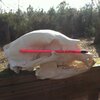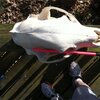I’ve had the opportunity and (largely) good fortune to kill thousands of animals with various 22LR’s, from 2lbs to 2,000. I kept a collection of hundreds of recovered bullets for many years, unfortunately lost somewhere in storage during a move from one home to another. Growing up, my father favored a rifle, while I always favored carrying a more compact pistol. Many theories were presented over the years - that handguns weren’t accurate enough, or lost too much velocity for quick kills... or that solids should be used in handguns, rather than hollow points, to make up for reduced velocity and subsequently reduced penetration... or, of course, locked breech rifles (bolts, levers, breaks) are more powerful than blowback semiautos...
However, demonstrated both across the chronograph and repeatedly on live game and livestock, none of the theories proved true. Skinning out animals and examining literally thousands of wound tracts over a couple decades has disproven any of these theories for me. Hollow points were just as likely to be found mushroomed against the skull of small game, failing to penetrate, whether fired from a rifle or a pistol, semiauto, bolt, or levergun. Odd things could occasionally happen, such as failed penetration of the skull, even with a rifle firing solids at muzzle-contact-range when dropping large livestock, such a pneumatic bolt gun (not bolt action), a set of felling hammers, or a shot behind the ear were all favorable to a head on “between the eyes” shot with a 22LR. And with relatively equal occasion, an animals body will inexplicably fight or dangerously flail long after terminal damage has been done to their brain.
All in view, I can’t pretend I have seen a remote difference in killing efficacy between a semiauto or bolt rifle in 22LR. Certainly not sufficient difference to declare one is obviously superior to the other.
More likely, the two rifles described in the OP were either a fluke, or some other variable step change. For instance, the guy who owned the bolt gun was shooting solids and the guy who owned the semiauto was shooting hollow points, or one using low noise and the other standard velocity ammo, or one high velocity and the other standard. Any of these variables has far, far more influence on killing efficacy than the non-influence of action type.





